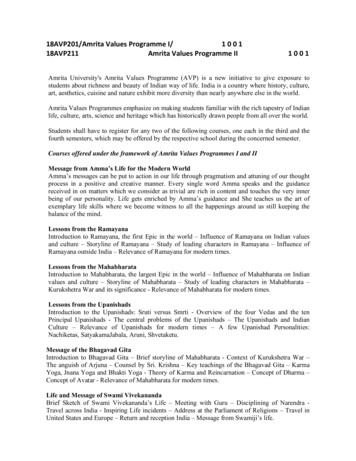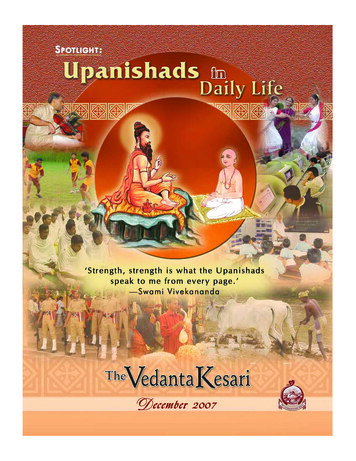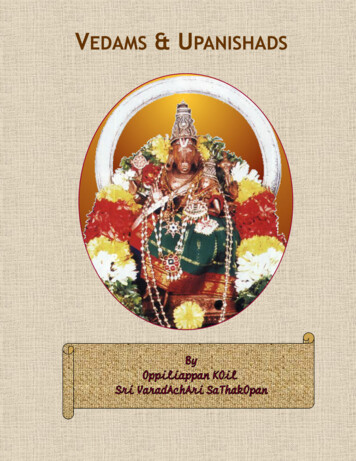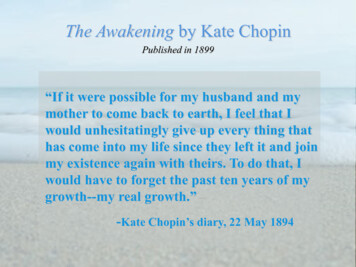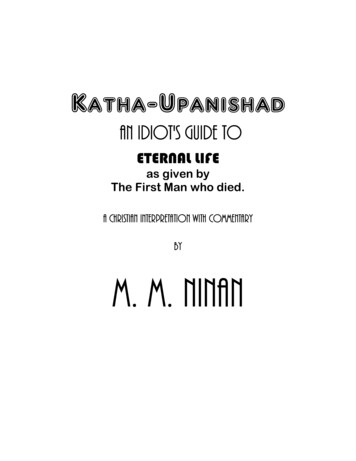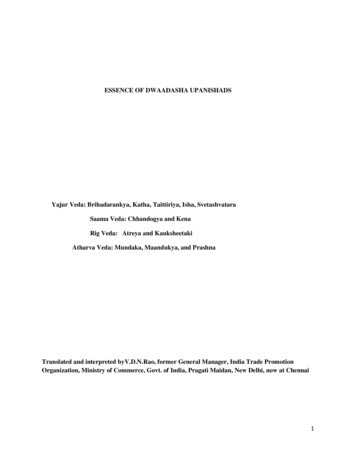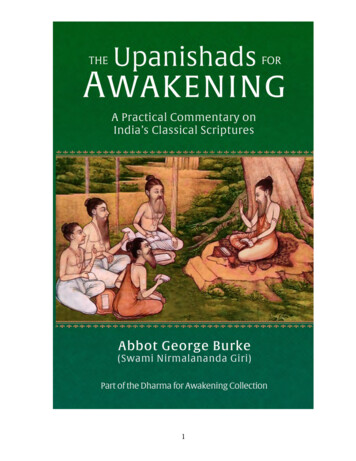
Transcription
1
The Upanishads For AwakeningbyAbbot George Burke(Swami Nirmalananda Giri) 2021 Light of the Spirit MonasteryLight of the Spirit PressCedar Crest, New Mexico, USALightoftheSpiritPress.comOCOY.org“Let those truths which are in theUpanishads live in me dedicated to the Self.”(Invocation at the beginning of the Kena Upanishad)2
PrefaceThe sacred scriptures of India are vast. Yet they are only different ways of seeingthe same thing, the One Thing which makes them both valid and ultimatelyharmonious. That unifying subject is Brahman: God the Absolute, beyond andbesides whom there is no “other” whatsoever.The thirteen major Upanishads are the fountainhead of all expositions ofBrahman. The word “upanishad” itself comes from the root word upasana, whichmeans to draw or sit near, and is usually considered to mean that which was heardwhen the student sat near the teacher to learn the eternal truths.We do not know who wrote the Upanishads. This has a distinct advantage inthat the image of a historical, finite personality does not intervene to obscure therevelation handed on to spiritual aspirants. The authority of the Upanishads restsnot upon those who wrote them, but upon the demonstrable truths they express.They are as self-sufficient and self-evident as the multiplication tables or the Tableof Elements. They are simply the complete and unobscured truth. And realization ofthat Truth alone matters.The teachings of the Upanishads are the supreme expressions of the eternalwisdom, the eternal vision of the ancient rishis (sages) of India. Consequently,though simple in their mode of expression, they can be extremely difficult to grasp.There are many things in this world that we need not know, but the truthsembodied in the Upanishads and their inspired digest-summary, the Bhagavad Gita,are invaluable for all who would ascend to higher consciousness.The Upanishads have long interested students of philosophy in the West. TheEnglish philosopher David Hume translated some of them into English in theeighteenth century. Later he travelled to America where he taught Sanskrit toThomas Jefferson and together they studied the Upanishads in their original form.In this commentary I am using the translation of Sarvepalli Radhakrishnan, oneof India’s most distinguished scholars in religion and philosophy. He was also thefirst Vice President of India (1952–1962) and the second President of India from1962 to 1967. His works, which included English translations of the Upanishads,the Bhagavad Gita and the Dhammapada, are of continuing value both intellectuallyand spiritually. Here I am giving only his translation of the upanishadic texts, buthis translation, The Principal Upanishads, contains the original Sanskrit text intransliteration and a great deal of notes to clarify the text. So I recommend youobtain this most valuable book as a major element in your spiritual library. TheUpanishads: Breath of the Eternal by Swami Prabhavananda is a beautiful interpretivetranslation like his marvelous translation: Bhagavad Gita: The Song of God. Irecommend that you obtain them both.I have only commented on passages that seemed to need it. But I have includedall the passages that convey eternal truths and need no comment. I have omitted3
passages that do not deal directly with realization of the Self or those which are soobscure (especially in symbolism as well as the ancient form of Sanskrit) it isanyone’s guess as to what they really mean.4
Brihadaranyaka UpanishadIn the beginning this (world) was only the Self [Atman], in the shape of aperson. Looking around he saw nothing else than the Self. He first said, I amSoham [I am That]. (1.4.1)Soham is the “first speaking” of the Absolute Itself: the expression of theknowledge and knowing of the Self. Soham is the Name (Embodiment) of thePrimeval Being, the Self of the Universe and the Self of our Selfs. Soham is theConsciousness of Brahman and of the Self of each one of us. We, too, are Soham.In the section of the Yoga Sutras (1:27) dealing with Ishwara, the Supreme Lord,also known as Viraj, Patanjali makes this statement: Tasya vachakah pranavah–“Hisvachaka is the pranava.” “Vachaka” means speech or speaking. “Pranava” meansLife, Life-Giver and Breath Principle: the Breath Word. It is commonly thought of asOm, but integrating this with the verse we have been considering, we see that theBreath Word is Soham. For “he first said: ‘Soham.’” Patanjali continues regardingthe Pranava: “Its constant repetition and meditation [is the way]. From it [result]the disappearance of obstacles [to enlightenment] and turning inward ofconsciousness” (1:28-29). Soham is the Breath and Life Word. Ishwara “speaks”Soham as the foundation of the universe, as the evolutionary life force within thecosmos and every individual being.This is a key verse in the Upanishads, as it relates to both the philosophy of ourtrue nature and the interior yogic process by which we realize it. We invoke ourlower self when we say “I,” but in meditation we invoke our higher, divine Selfwhen we mentally intone Soham in time with the breath: So when we inhale, andham when we exhale. (See Soham Yoga: The Yoga of the Self regarding this as the meansto Self-realization.) In the sixteenth verse of the Isha Upanishad it says: “I am thatPurusha: I am Soham.”At that time this [universe] was undifferentiated. It became differentiatedby name and form. He [the Self] entered in here, as a razor is [hidden] in therazor-case, or as fire in the fire-source. The Self is to be meditated upon, forin it all these become one. (1.4.7)At that time this [universe] was undifferentiated. It became differentiated by name andform.At first only undifferentiated Unity existed, but inherent in It was all relativeexistence. Consequently it expanded into the cosmos–causal, astral, and physical–which is nothing but endless variations of name (nama) and form (rupa). Thiscould only be true because the universe is fundamentally ideational (conceptual) innature, and only an idea or dream in the consciousness of God and all sentientbeings. Everything we see or experience is a thought in the minds of God andourselves. That is why liberation is only a matter of awakening, of the5
transformation of consciousness. Even good deeds are really just good thoughts.Thought and act are the same thing, however differently they may seem to us whoare asleep in the dream. Enlightenment is living awake in the dream. (See therecording of Paramhansa Yogananda, Awake in the Cosmic Dream.) This is why all trueyoga takes place solely in the mind, even if we experience physical phenomenaduring its practice. And the results we are after are purely psychological. This is amajor fact for yogis to know.The only way we can manage in the world of duality is to acknowledge and dealwith name and form as realities, which they are, but only temporary ones. It iswhen we think they are all there is to life, here or hereafter, that we get intodelusion and the misery of samsara begins and lasts long, through creation cycles.To awaken from the dream and be free is an option open only to the yogi whoknows, “I am Soham.”Meditation on that which is not the Self is pointless. Leaving name and formbehind we must begin with the invocation of non-dual Reality that in the beginningwas Soham. (Again, see Soham Yoga: The Yoga of the Self.)That Self is dearer than everything else and is innermost. (1.4.8)Nothing that is finite and external to us can satisfy us, because the only reality isinfinite and within us. And that infinite and inmost entity is our own Self.Those who seek the Self as not just the highest but the only good, certainly seethe world around them in a manner totally opposite to those who do not hold theSelf as dearer than everything else and innermost.Whoever worships another divinity (than his Self) thinking that he is oneand (Brahman) another, he knows not. (1.4.10)If we begin with ignorance we will end up with ignorance. Those who approachspiritual life with any perspective other than the truth of their identity with the Selfand the Supreme Self, Brahman, will not come to the Knowing that is really Selfrealization, the awakening into the consciousness of the Self and Brahman, the Selfof the Self.Even if one performs a great and holy work, but without knowing this,that work of his is exhausted in the end. One should meditate only on the Selfas his (true) world. The work of him who meditates on the Self alone as hisworld is not exhausted for, out of that very Self he creates whatsoever hedesires. (1.4.15)All that we attain outside the knowledge of the Self will melt and vanish away.This is the simple truth. Therefore Atmajnana, knowledge of the Self, should be thecentral pursuit of our life.Only a matter of days before commenting on this verse, I read in a book of theteachings of Sri Gajanana Maharaj, a great twentieth century master yogi, that theyogi who applies himself to sadhana for the realization of the Self becomes himself6
the granter of all his desires.The great teacher, Ajatashatru, was asked by a man named Gargya to teach himthe truth about Brahman. Ajatashatru agrees, and this is what occurred:Taking him [Gargya] by the hand he rose. The two together came to aperson who was asleep. They addressed him with these names: Great, Whiterobed, Radiant Soma. The man did not get up. He woke him by rubbing himwith his hand. He then got up. (2.1.15)Occasionally in the Upanishads we find humor used to make a point, and this isone of them. Coming across a sleeping man, Ajatashatru addressed him as thedivine Self: “Great, White–robed, Radiant Soma.” But it did no good, for the manwas unconscious. It was pointless to address him at all. In the same way, all thepositive affirming and philosophizing are worthless if the speaker and the hearersare spiritually asleep! Such sleepers do not need high-sounding words about theSelf: they need to awaken. So Ajatashatru shook him until he woke up. We need tobe shaken up, to awaken and see with our real eyes and hear with our real ears.Otherwise nothing meaningful will go on. The truth being spoken to us meansnothing if we are not awake to hear it. Yoga is the great awakener. Other factors candisturb our sleep, get us to open our eyes a bit and then go back to sleep and justmumble and turn over and sleep on. But yoga alone fully awakens us. All thereligion and piety mean absolutely nothing if we are not awake and clear in themind.Verily, not for the sake of all is all dear, but all is dear for the sake of theSelf. Verily, it is the Self that should be seen, heard of, reflected on andmeditated upon. Verily, by the seeing of, by the hearing of, by the thinking of,by the understanding of the Self, all this is known. (2.4.5)The Self (Atman) is of the nature of bliss (ananda). When something makes ushappy, it is not the thing itself that is the source of happiness, but rather the touchof the joy that is the Self which we experience. Actually, our response to that thingopens the barrier between us and the Self for a while, and like the light comingthrough the shutter of a camera we get a flash, a glimpse, of the bliss of the Self.What we are really valuing is that touch of the Self, but in our ignorance we thinkthose objects are the source. Therefore it really is because of (“for the sake of ”) theSelf that they are thought by us as dear.The wise seek to know the Self through study, deep thought, and meditationupon the Self. And we are assured that “by the seeing of, by the hearing of, by thethinking of, by the understanding of the Self, all this is known.”To know the Self is to know everything. To not know the Self is to knownothing.As a lump of salt thrown in water becomes dissolved in water and there7
would not be any of it to seize forth as it were, but wherever one may take[taste] it is salty indeed, so, verily, this great being, infinite, limitless, consistsof nothing but consciousness [samjnana]. (2.4.12-14)Nothing exists but infinite, limitless Consciousness: Brahman. There is no placeor no thing that is not essentially Consciousness. The Self-realized person perceivesthis directly and continuously. The enlightened individual does not go into a kind ofnon-dual coma in which nothing is perceived. Rather, those who know Brahmanstill hear and see names and forms as before, but now they know that they areseeing only the Supreme Self. They do not just believe that, they perceive that to beso. Only the One remains, however many things might be seen in the cosmicdream.This shining, immortal person who is in this earth and with reference tooneself, this shining, immortal person who is in the body, he, indeed, is justthis Self. This is immortal, this is Brahman, this is all. (2.5.1)Within this material creation, as the Projector of the dream creation, is the selfluminous, immortal Person, the Parampurusha, the Cosmic Dreamer. And withinthis material body is the self-luminous, immortal Self, the jiva, the individualpurusha who is dreaming along with the Dreamer its personal, finite dream ofincarnation after incarnation.This Self, verily, is the lord of all beings, the king of all beings. As all thespokes are held together in the hub and felly of a wheel, just so, in this Self,all beings, all gods, all worlds, all breathing creatures, all these selves are heldtogether. This, verily, is the person dwelling in all bodies. There is nothingthat is not covered by him, nothing that is not pervaded by him. ThisBrahman is without an earlier and without a later, without an inside, withoutan outside. This Brahman is the Self, the all-perceiving. (2.5.15, 18, 19)It is this dynamic Unity beyond past, future, inside or outside which we mustrealize and recognize as the Self of our Self, the Consciousness in ourconsciousness.Perhaps the greatest of the sages whose teaching are presented in theUpanishads was Yajnavalkya. He was once asked:Since everything here [in this world] is pervaded by death, sinceeverything is overcome by death, by what means does the sacrificer freehimself from the reach of death?[Yajnavalkya replied:] By speech [vak]. Verily, through speech. This[speech] is freedom [mukti–liberation], this is complete freedom. (3.1.3)By the power of sound liberation is attained, as is stated by the last sutra of theBrahma Sutras. Through mantric invocation of the Immortal, the yogi becomesliberated, not partially but completely.8
Yajnavalkya, said he: When such a person [a liberated sage] dies, do thevital breaths move up from him or do they not?No, replied Yajnavalkya. They are gathered together in him. (3.2.11)Just as a snake sheds its skin, so the liberated person leaves his material(annamaya) body behind. But his subtle astral and causal energy bodies merge intohim, are literally transmuted and assumed into spirit. For after all, everything isessentially spirit in manifestation.Yajnavalkya, said he: When such a person dies, what is it that does notleave him?The name. The name is infinite. Thereby he [who knows this] wins aninfinite world. (3.2.12)“Name” here means the mantric designation/embodiment of the Self, of PureConsciousness: Soham. In the very first verse I have commented on it says that theCosmic Self in the beginning first said: Soham asmi: “I Am Soham.” And as we willsee later in the sixteenth verse of the Isha Upanishad, the departing Self saysexactly the same: “I Am Soham.”He who breathes in with your breathing in is the Self of yours which is inall things. He who breathes out with your breathing out is the Self of yourswhich is in all things. He is your Self which is in all things. (3.4.1)Inhalation and exhalation are direct manifestations of the Self, and thereforebreath yoked to sound is the yogi’s indispensible tool. It is the Self which breatheswithin the breath, vibrating So during inhalation and Ham during exhalation.Therefore the yogi observes his breath and mentally intones the same in order tolink with and merge into the consciousness that is his Self.You cannot see the seer of seeing, you cannot hear the hearer of hearing,you cannot think the thinker of thinking, you cannot understand theunderstander of understanding. He is your Self which is in all things.Everything else is of pain [arta]. (3.4.2)Sri Ramakrishna was once asked: “What is the Self?” He answered: “Thewitness of the mind,” which includes all the perceptions of the senses. It isConsciousness Itself.Arta means pain(ed), distress(ed) and affliction (afflicted), which certainly applyto both the world and those in it. Everything but the Self is arta.He who dwells in all beings, yet is within all beings, whom no beingsknow, whose body is all beings, who controls all beings from within, he isyour Self, the inner controller, the immortal. Thus far with reference to thebeings. Now with reference to the Self.He who dwells in the breath, yet is within the breath, whom the breathdoes not know, whose body the breath is, who controls the breath from9
within, he is your Self, the inner controller, the immortal. (3.7.15-16)Again we see why breath is indispensible to the yogi, and why the breath is thefoundation of authentic Raja Yoga–not the contortions of the breath produced bythe breathing exercises of Hatha Yoga, but the Atmic Breath, the natural,spontaneous breath of the Self which vibrates So and Ham as its essence.Verily, that Imperishable is unseen but is the seer, is unheard but is thehearer, unthought but is the thinker, unknown but is the knower. There is noother seer but this, there is no other hearer but this, there is no other thinkerbut this, there is no other knower but this. (3.8.11)Infinite Consciousness pervades everything. That is Brahman. And the KathaUpanishad says to each one of us: Tat Twam Asi: Thou Art That.Then Vidagdha Sakalya asked him, How many gods are there, Yajnavalkya?He answered: Three hundred and three, and three thousand and three.How many gods are there, Yajnavalkya?Thirty three.How many gods are there, Yajnavalkya?Six.How many gods are there, Yajnavalkya?Three.How many gods are there, Yajnavalkya?Two.How many gods are there, Yajnavalkya?One and a half.How many gods are there, Yajnavalkya?One. (3.9.1)Depending on how we look at it, there are many gods and yet only One. In thefollowing twenty-seven verses there are enumerations of the gods indicated by allthe numbers before One. You will find them in the complete translation of theUpanishads. But at the very end we find this:Which is the one God?The Breath [Prana]. He is Brahman. They call him tyat [that]. (3.9.9)Here again we see why the breath is an indispensable element of yoga sadhana.The Self is not this, not this [neti, neti]. He is incomprehensible for he isnever comprehended. He is undestructible for he cannot be destroyed. He isunattached for he does not attach himself. He is unfettered, he does notsuffer, he is not injured. (4.2.4)This very clear, but let us recall the glorious words of the Bhagavad Gita:“It is known that the unreal never comes to be, and the real never ceases to be.The certainty of both of these principles is seen by those who see the truth. Know10
indeed that That by which all this universe is pervaded is indestructible. There is noone whatsoever capable of the destruction of the Eternal.“Neither is the Self slain, nor yet does it die at any time; nor having been will itever come not to be. Birthless, eternal, perpetual, primeval, it is not slain wheneverthe body is slain. This Self by weapons is cut not; this Self by fire is burnt not; thisSelf by water is wet not; and this Self is by wind dried not. This Self cannot be cut,burnt, wetted, nor dried. This primeval Self is eternal, all-pervading, andimmovable. Unmanifest, unthinkable, this Self is called unchangeable” (2:16-17,20, 23-25)That Self is, indeed, Brahman, consisting of [or identified with] theunderstanding, mind, life, sight, hearing, earth, water, air, ether, light and nolight, desire and absence of desire, anger and absence of anger, righteousnessand absence of righteousness and all things. This is what is meant by saying,[it] consists of this [what is perceived], consists of that [what is inferred].According as one acts, according as one behaves, so does he become. The doerof good becomes good, the doer of evil becomes evil. One becomes virtuousby virtuous action, bad by bad action. Others, however, say that a personconsists of desires. As is his desire so is his will; as is his will, so is the deedhe does, whatever deed he does, that he attains. (4.4.5)This is a description of both Brahman and the Self in their relation with relativeexistence. It is especially an outline of the dream-life of the individual spirit. For inall these identifications and changes, the Self is unchanging, in all these births anddeaths the Self remains birthless and deathless. The fact that we so easily forget thistruth is evidence of how good we are at fooling ourselves. We are always masters ofthe situation.I especially want to point out that the Upanishad is not saying that by doinggood one becomes good. Rather it is saying that good dream actions produce gooddreams, that the quality of the role the individual person is playing in the dreamchanges according to the person’s actions. But it is only a drama, the reality beingthat the Self is never really a part of relativity, nor can the dreams of relativity affectthe true, transcendent nature of the Self, any more than Brahman is affected by thechanges of the dream creation.On this there is the following verse: “The object to which the mind isattached, the subtle Self goes together with the deed, being attached to italone. Exhausting the results of whatever works he did in this world hecomes again from that world, to this world for [fresh] work.” This [is for] theman who desires. But the man who does not desire, he who is without desire,who is freed from desire, whose desire is satisfied, whose desire is the Self,his breaths do not depart. Being Brahman he goes to Brahman.On this there is the following verse: “When all the desires that dwell inthe heart are cast away, then does the mortal become immortal, then he11
attains Brahman here [in this very body].” Just as the slough of a snake lieson an anthill, dead, cast off, even so lies this body. But this disembodied,immortal life is Brahman only, is light indeed.On this there are the following verses: “The narrow ancient path whichstretches far away, has been touched [found] by me, has been realized by me.By it, the wise, the knowers of Brahman go up to the heavenly world after thefall of this body, being freed [even while living].“That path was found by a Brahmana and by it goes the knower ofBrahman, the doer of right and the shining one.” (4.4.6-9)The way to realization is subtle. Without refinement of mind and the interiorfaculties of perception, yoga is not going on. Yoga is itself the purification of themind and heart in order to allow the highest powers of the individual to come intoplay and transform his life and consciousness. This is a total overhaul of externaland internal life, and yet it is only a part of yoga.The yogic path is long and “stretches far away.” It takes lifetimes–many if wedawdle, and not so many if we knuckle down and put our whole heart into it. So weneed to get busy. There can be no periods of coasting along, deluding ourselves thatour liberation is assured and just around the next corner. Buddha meditated andengaged in intense discipline right up to the moment of his leaving the body, eventhough he had attained enlightenment decades before. And so did SwamiSivananda. All real yogis do the same.The successful yogi is “freed even while living.” Liberation takes place right herein this world which is no longer an obstacle to enlightenment. By changing himselfthe yogi changes the effect the world has on him. What hindered him before nowhelps him. The once-closed door is now open to him. Death is the final goingthrough that door. For him there will be no return unless he wills it.It is interesting that “The narrow ancient path which stretches far away has beenfound by me” is paraphrased in the esoteric Creed of the Wedgwood-LeadbeaterMass, which says: “We believe in the Law of Good which rules the world and bywhich one day all His sons shall reach the feet of the Father, however far they stray:We strive towards the ancient narrow path that leads to life eternal. So shall Hisblessing rest on us and peace forevermore. Amen.”Into blind darkness enter they who worship ignorance; into greaterdarkness than that, as it were, they that delight in knowledge [enter].Those worlds covered with blind darkness are called joyless. To them afterdeath go those people who have not knowledge, who are not awakened.(4.4.10-11)Those who worship the darkness of ignorance enter the realms of darkness afterdeath. And those devoted to knowledge that is no true knowledge at all, but alsoignorance, enter into even darker worlds after death. That is why Jesus said: “Iftherefore the light that is in thee be darkness, how great is thatdarkness!” (Matthew 6:23). For if we are deluded and our “light” which we think is12
knowledge is really false and is darkness, we will never seek the true light.Any relative world is fundamentally joyless and enveloped in darkness, so thetruly wise understand. No world is fit to live in, for they are all realms of death andconstant change. There is no peace possible for those who live therein. But thosewho know the Self have ended that compulsion, for:If a person knows the Self as “I am this [purusha],” then wishing what,and for desire of what should he suffer in the body? (4.4.12)Needing nothing more than the Self, to what pain or trouble will he impelhimself, for whom or to what purpose? He abides in complete realization: I am thepurusha, the Self. Desire being the root of rebirth, when it is eliminated rebirthvanishes along with it.Whoever has found and has awakened to the Self that has entered into thisperilous, inaccessible place [the body], he is the maker of the universe, for heis the maker of all. His is the world, indeed he is the world itself. (4.4.13)Since the Self wills the entry into relative existence and the lives therein, it“makes” the universe. For the universe is but a dream within a dream, the dream ofthe individual Self within the dream of the Supreme Self.Verily, while we are here we may know this; if [we know it] not we wouldbe ignorant, great is the destruction. Those who know this become immortalwhile others go only to sorrow. (4.4.14)This is a truth which our earthly experiences prove over and over, yet humanbeings run after everything but Brahman, thinking that outside Brahman peace andfulfillment is possible. The suffering may be very subtle, but it will be there,nonetheless.If one clearly beholds him as the Self, as God, as the lord of what has beenand what will be, he does not shrink away from him. (4.4.15)Since darkness is dispelled by light, those who dwell in darkness while thinkingit is light run away from the light lest it take away their false “light.” Insane as it is,humans run after that which pains and destroys them and run away from thatwhich can end all suffering and death for them. This is what it means to be trulynegative: darkness is seen as light and light is seen as darkness. It is like aphotographic negative in which the light portions are dark and the dark portions arelight. As long as we cling to the unreal, to darkness and to death, we cannot be ledto the Real, to the Light and to Immortality. What a terrible condition!That in front of which the year revolves with its days, that the godsworship as the light of lights, as life immortal.That in which the five groups of five and space are established, that alone Iregard as the Self. Knowing that immortal Brahman I am immortal.13
(4.4.16-17)In this creation, things are grouped in fives, such as the five senses, the fivebodies, etc. All rest in the immortal Self. When one knows that Self as Brahman, herealizes: “I am immortal.”I am simply going to give much of the rest of this section without comment,because by now I am sure you get the idea which has been repeated in so manyvarious and wise ways. And yet I hope you feel like Arjuna when he told Krishna:“Explain to me further in detail your powers and manifestations. I am neversatiated with hearing your amrita-like words” (Bhagavad Gita 10:18).They who know the life of life, the eye of the eye, the ear of the ear andthe mind of the mind, they have realized the ancient primordial Brahman.Only by the mind is it to be perceived. In it there is no diversity. He goesfrom death to death, who sees in it, as it were, diversity.This indemonstrable and constant being can be realized as one only. TheSelf is taintless, beyond space, unborn, great and constant.Let a wise Brahmana after knowing him alone, practice [the means to]wisdom. Let him not reflect on many words, for that is mere weariness ofspeech.Verily, he is the great unborn Self who is this [person] consisting ofknowledge among the senses. In the space within the heart lies the controllerof all, the lord of all, the ruler of all. He does not become greater by goodworks nor smaller by evil works. He is the bridge that serves as the boundaryto keep the different worlds apart. Him the Brahmanas seek to know by thestudy of the Veda, by sacrifices, by gifts, by penance, by fasting. On knowingHim in truth, one becomes an ascetic. Desiring Him only as their worlds,monks wander forth. Verily, because they know this, the ancient [sages] didnot wish for offspring. What shall we do with offspring [they said], we whohave attained this Self, this world. They, having risen above the desire forsons, the desire for wealth, the desire for worlds, led the life of a mendicant.For the desire for sons is the desire for wealth and the desire for wealth is thedesire for worlds; both these are, indeed, desires only. The Self is [that whichhas bee
The Upanishads have long interested students of philosophy in the West. The English philosopher David Hume translated some of them into English in the eighteenth century. Later he travelled to America where he taught Sanskrit to Thomas Jefferson and together they studied the Upanishads in their original form.

